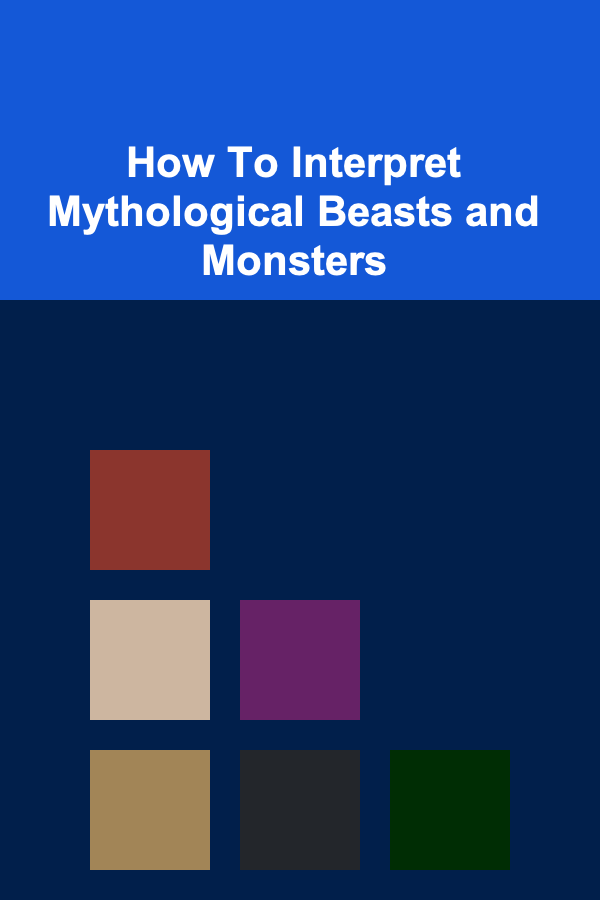
How To Interpret Mythological Beasts and Monsters
ebook include PDF & Audio bundle (Micro Guide)
$12.99$11.99
Limited Time Offer! Order within the next:

Mythological beasts and monsters are a fascinating element of various cultures' folklore and mythology. They represent a blend of human imagination, spiritual beliefs, and cultural symbolism. From the fire-breathing dragons of European folklore to the multi-headed serpents of Greek mythology, these creatures often embody more than just terror and awe---they hold deeper meanings that reflect the values, fears, and desires of the societies that created them. In this article, we will explore how to interpret these mythological beings, understanding the various ways they function in different cultures and how their symbolism can offer insights into human psychology and society.
The Role of Mythological Beasts in Folklore and Religion
Mythological creatures have existed in folklore across the world for centuries, playing a variety of roles within religious, cultural, and societal contexts. They often emerge as symbols of chaos, danger, or divine punishment, but they can also represent order, protection, or wisdom. The interpretation of these creatures varies depending on the culture, era, and beliefs of the people who created them.
1.1 Creation Myths and Cosmic Beasts
In many ancient cultures, mythological beasts and monsters were seen as primordial creatures that existed before the creation of the world or the establishment of cosmic order. For example, in Norse mythology, Jörmungandr, the world serpent, encircles the Earth and is a symbol of chaos and destruction. It is only through the eventual defeat of such creatures that balance and order are restored to the world.
In other traditions, beasts are not destructive forces but rather represent the untamed forces of nature that humanity must learn to tame and understand. The Zoroastrian mythological creature Aži Dahāka, a three-headed dragon, represents the destructive aspects of nature that must be conquered by good forces for the world to be stabilized.
1.2 Gods and Monsters
In addition to cosmic beasts, many mythological traditions also feature gods or divine beings who are associated with monstrous forms. These gods often serve as protectors, guardians, or bringers of destruction. In Greek mythology, the god Typhon, who had a hundred heads and was associated with volcanic eruptions and storms, embodies the terrifying forces of nature. However, Typhon's defeat by Zeus also highlights the triumph of order over chaos.
Similarly, the Hindu goddess Kali is depicted as a fierce and destructive figure, often with multiple arms and a fearsome face, embodying the destructive aspect of life and death. While her form may seem monstrous, she is ultimately seen as a force of protection and transformation. In both of these examples, monsters can be understood as representations of the duality of life---destruction and creation, fear and power, chaos and order.
The Psychological and Symbolic Meaning of Monsters
Monsters are not just physical creatures but symbolic representations of the human psyche. They often reflect our deepest fears, desires, and the conflict between order and chaos that exists within all human beings. Understanding the psychological significance of mythological beasts can offer insights into the ways that cultures have grappled with universal themes such as death, power, and transformation.
2.1 Monsters as Manifestations of Fear
One of the most common interpretations of mythological monsters is that they represent deep-seated fears, often those that are difficult or impossible to confront directly. In this context, monsters act as externalizations of the things that terrify us. In many cultures, the dragon, for example, is a powerful and frightening creature that often symbolizes uncontrollable forces like nature, death, and the unknown.
The Greek myth of the Gorgon Medusa is another example. Medusa's gaze turns people to stone, symbolizing the fear of death and the inevitability of fate. Her transformation into a monster reflects the idea of how fear can distort our perception of reality, turning something once familiar into something monstrous.
Similarly, the werewolf in European folklore is a symbol of the fear of uncontrollable urges and the loss of one's humanity. The curse of lycanthropy represents the dual nature of the human soul, the battle between civility and primal instincts.
2.2 Monsters as Catalysts for Transformation
While monsters often embody fear, they can also symbolize opportunities for growth and transformation. In many mythologies, a hero must confront a monster in order to achieve personal or societal transformation. This theme is pervasive in stories like the Greek myth of Hercules and the Hydra, or the tale of St. George and the dragon. The defeat of the monster signifies overcoming the darkness or chaos within oneself or society.
In Jungian psychology, the process of confronting and integrating the "shadow" (the unconscious and repressed parts of the psyche) is crucial for personal development. Monsters in mythology often represent this shadow aspect of the psyche, and by confronting them, the hero achieves a higher level of self-awareness and growth. In this way, monsters are not just obstacles to be overcome---they are essential to the process of individuation, the journey toward self-realization.
2.3 Monsters as Guardians of Knowledge
In some cultures, monsters are not simply destructive forces, but guardians of wisdom and knowledge. For example, the Sphinx in Greek mythology posed riddles to those who wished to pass, ensuring that only the wise could move forward. Similarly, the Norse mythological creature Fafnir, a dragon, hoards gold and wisdom. To obtain the treasure, a hero must defeat the beast, which symbolizes the struggle between acquiring knowledge and the dangers that come with it.
The idea of monsters as gatekeepers to wisdom can also be seen in the role of serpents in many mythologies. In the Abrahamic traditions, the serpent in the Garden of Eden represents temptation and the pursuit of forbidden knowledge. While often seen as a negative figure, the serpent also embodies the quest for enlightenment and the consequences of transcending innocence.
Mythological Monsters Across Cultures
Different cultures have their own unique mythological creatures, and understanding them requires exploring their specific symbolism and roles. Although the forms and names of these creatures may vary, many share common themes that reflect universal human concerns.
3.1 Dragons
Dragons are one of the most iconic mythological creatures, appearing in myths and legends across the world. In Western folklore, dragons are often depicted as fearsome, fire-breathing beasts that hoard treasure. They are typically adversaries to be defeated by knights or heroes. In contrast, in Chinese mythology, dragons are benevolent and associated with power, wisdom, and protection. The difference in how dragons are perceived in different cultures can be interpreted as reflecting the values and fears of those cultures.
In the West, the dragon symbolizes the chaotic forces of nature or evil that must be overcome by human strength and virtue. In the East, dragons embody the balance between human civilization and the natural world, often representing the harmony between the two.
3.2 The Chimera and the Hydra
The Chimera, a creature from Greek mythology, is often depicted as a hybrid beast with the head of a lion, the body of a goat, and the tail of a serpent. The Chimera represents the fear of the unknown and the unnatural combination of conflicting elements. Its very existence is a challenge to the natural order.
The Hydra, also from Greek mythology, is another multi-headed creature that represents the challenge of facing an ever-growing problem. When one of its heads is cut off, two more grow in its place. The Hydra symbolizes the idea of problems or challenges that multiply the more we attempt to solve them, and thus the difficulty of overcoming forces that seem insurmountable.
3.3 Otherworldly Monsters in Norse and Celtic Mythology
In Norse mythology, monsters like Jörmungandr, the Midgard serpent, and Fenrir, the wolf, are central to the apocalyptic Ragnarök, which is the end of the world and the rebirth of it. These monsters are not just adversaries to gods but symbolize the inevitable cycle of destruction and rebirth. The creatures are often linked to chaos, destruction, and the fragility of life, reinforcing the idea that destruction is necessary for the creation of something new.
Similarly, in Celtic mythology, monsters like the Cailleach (a hag who represents winter and death) and the various fairy creatures are often seen as embodiments of natural forces or the boundaries between life and death. These monsters highlight the cyclical nature of life, death, and rebirth, reflecting the ancient Celts' reverence for nature and its powerful, uncontrollable forces.
Conclusion
Mythological beasts and monsters are not just figures of terror---they are deeply symbolic, often representing the fundamental aspects of human experience, including fear, growth, transformation, and the struggle for meaning. Through an exploration of various mythologies and the roles these creatures play, we gain valuable insights into how different cultures have confronted the unknown and grappled with the complex dynamics of life and death.
By interpreting mythological beasts in this way, we can see that they serve as mirrors to our own inner lives, reflecting the universal challenges and triumphs that define the human condition. They remind us that monsters, whether external or internal, are not simply to be feared---they are to be understood, confronted, and ultimately integrated into the narrative of our own lives.

How to Invest in Foreign Exchange (Forex) Markets for Profit
Read More
How to Make a Family Vision Board for the Year Ahead
Read More
How to Make Informed Decisions When Choosing Generic Medications
Read More
How to Organize Your Jewelry Collection Effectively
Read More
How To Write a Speech That Entertains
Read More
How To Identify and Avoid Phishing Scams
Read MoreOther Products

How to Invest in Foreign Exchange (Forex) Markets for Profit
Read More
How to Make a Family Vision Board for the Year Ahead
Read More
How to Make Informed Decisions When Choosing Generic Medications
Read More
How to Organize Your Jewelry Collection Effectively
Read More
How To Write a Speech That Entertains
Read More